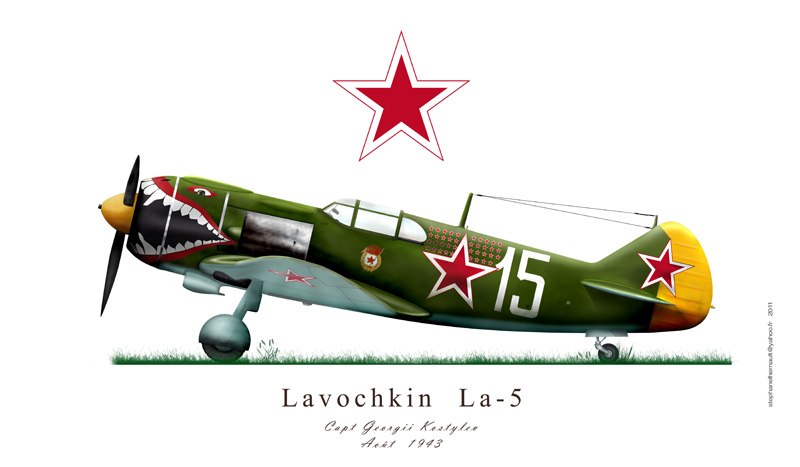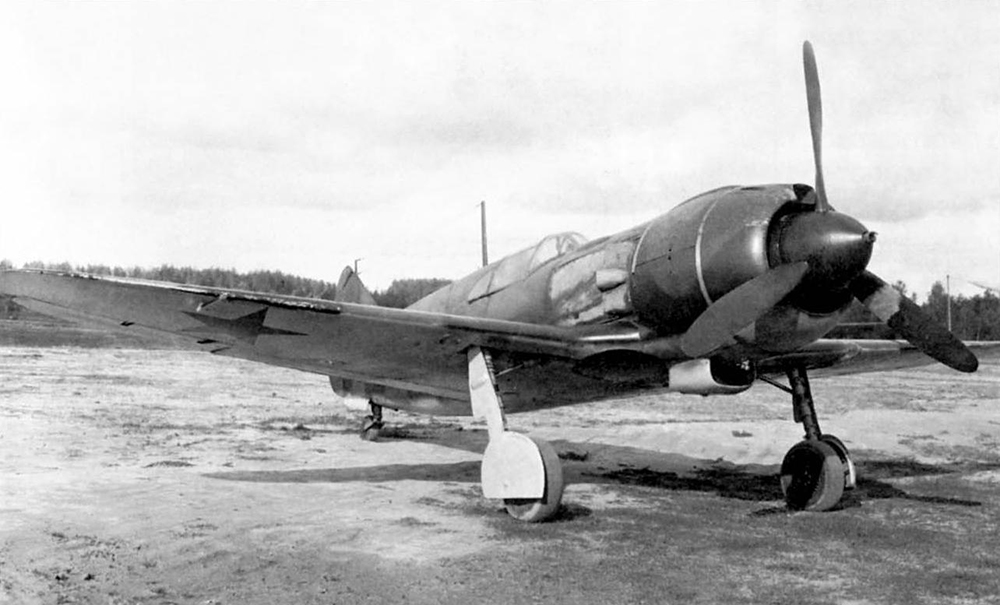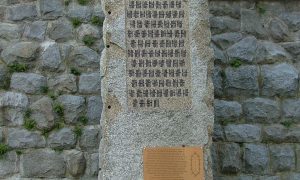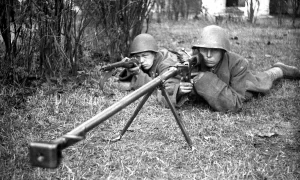La-5 (original name – LaGG-5 ) is a Soviet single-engine fighter, created in 1942 by OKB-21 under the leadership of S.A. Lavochkin and Produced from July 1942.
In the late 1930s, all production fighters in the Soviet Union were based on a mixed design. Despite all the shortcomings in the use of wood (mainly – the greater weight of the structures in the required rigidity), the creation of ” delta-wood ” and the advancement of the LaGG-1 / LaGG-3 aircraft project, built using these materials, led to the emergence of a modern fighter of solid wood construction. Wood products required very high qualifications of workers. The entire fuselage of the LaGG-3 (from which the LaGG-5 was later made) was assembled on glue, which required the strictest compliance with the requirements for temperature, humidity and dustiness in the workshop. The prototype of the aircraft was polished with great care and varnished to reduce aerodynamic drag. All these factors led to the fact that in serial production the LaGG-3 was a slightly different aircraft than in testing, and demanded, already at birth, modernization.
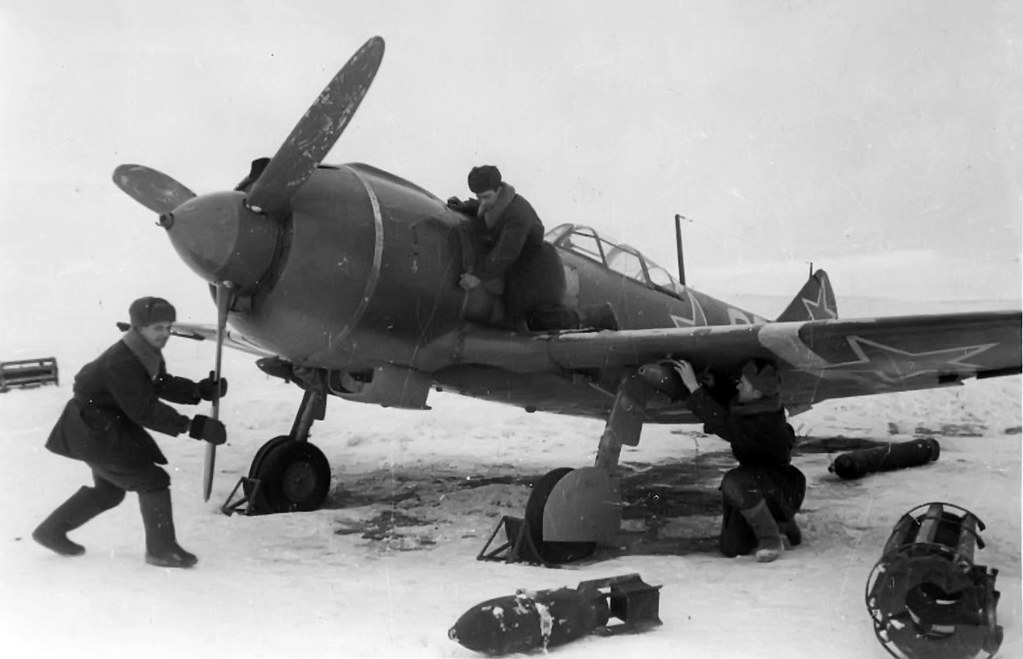
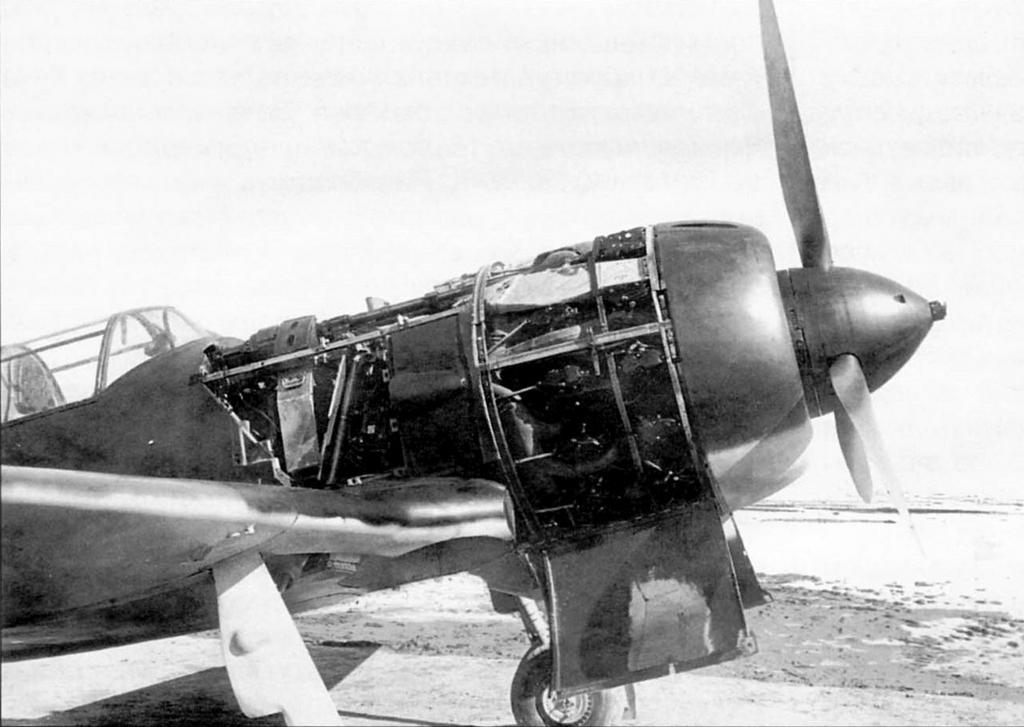
Despite the fact that the LaGG-3 had a number of design flaws and was difficult to fly, the pilots treated this aircraft with respect, admitting that piloting it was not an easy matter and required additional training.
In battles LaGG fighters proved to be a tenacious vehicles capable of returning to home base with a fuselage resembling a “sieve”. But at the beginning of 1942, the LaGG-3 could no longer fight on equal terms with new modifications of German fighters. The pilots complained about the weak armament of the vehicle, initially equipped with only three machine guns, as well as the insufficient supply of ammunition. Lavochkin, meeting the demands of the front-line soldiers, increased the caliber of weapons and ammunition, thereby making the structure heavier. Speed and climb rate dropped sharply. The main problem was the motor. The LaGG-3 had an M-105P liquid-cooled engine with a capacity of 1050 liters, but its power was not enough for a heavy machine of an all-wood construction. Lavochkin pinned his hopes on a new in-line liquid-cooled engine M-107. With the same dimensions as the serial M-105, V. Klimov’s new engine (a distant descendant of the French Hispano-Suiza 12 Ybrs engine, purchased under license) developed a takeoff power of 1400 hp with and at an altitude of 5 km – 1300 liters. In this regard, the design bureau of Lavochkin and Yakovlev was instructed to develop fighters based on this engine. Engines of the M-105 series installed on the LaGG-3 were also in short supply, since they were used on the Yak-1 / Yak-7 and Pe-2.
In this regard, by January 1942, the development of the LaGG fighter was on the verge of closure. The war gave preference to the already established production of the Yak-7, so Lavochkin had to urgently look for a new engine. His design bureau decided to replace the water-cooled engine with an air-cooled engine – ASh-82. According to the People’s Commissar of the Aviation Industry A. Shakhurin, this replacement solved a problem of great national importance. It so happened that all the fighters tested in 1940 had water-cooled engines. At least 40% of the engines produced at engine plants were air-cooled. It was practically impossible to transfer the plant from the production of air-cooled motors to water-cooled ones during the war, since this required changing almost all the equipment. Therefore, with an acute shortage of water-cooled engines, there were significant stocks (this is 1942!) Of air-cooled aircraft engines. It was these reserves that made it possible to quickly provide the front with an urgently needed fighter.
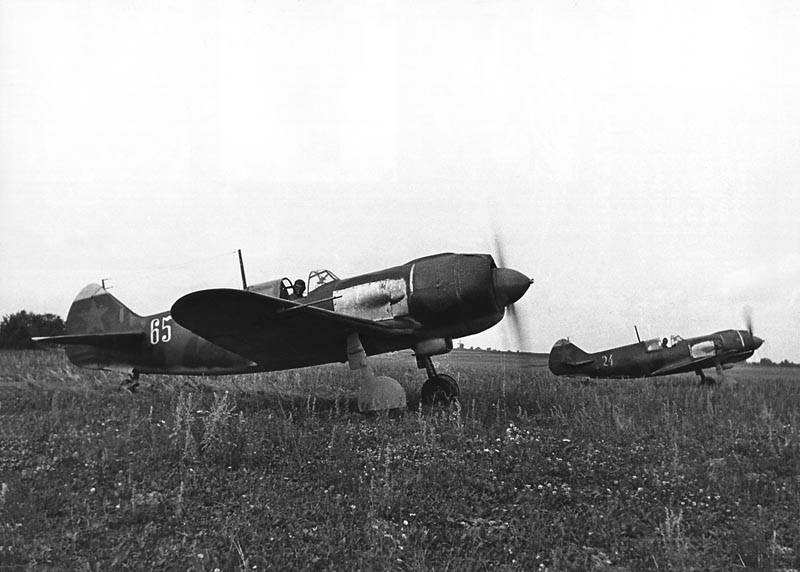
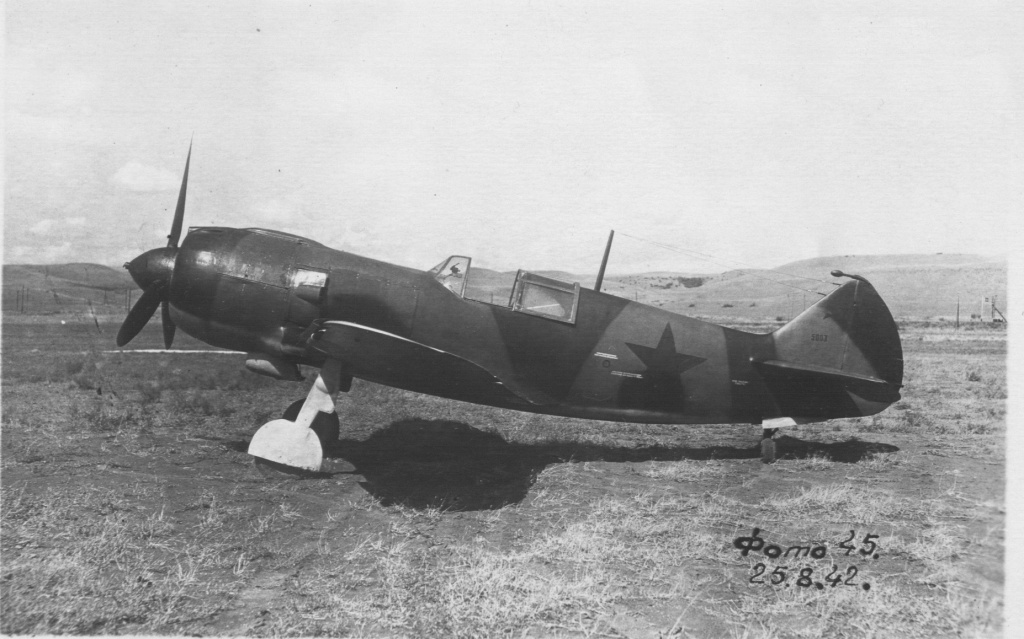
Due to the discrepancy in size and greater weight, the engine could not be installed on the existing frame without significant alterations and, accordingly, the investment of time, and this was a critical moment. However, Lavochkin’s deputy, S.M. Alekseev, managed at an incredible pace, without calculations and drawings, to make a prototype of the aircraft. In connection with the decision of the State Defense Committee to withdraw LaGG-3 from production and transfer the factories at which it was produced to the Yakovlev Design Bureau and the organization of production of Yak fighters on them, the situation for Lavochkin Design Bureau was critical. However, on March 21, 1942, a few days before the Lavochkin Design Bureau was sent to Tbilisi, test pilot Vasily Mishchenko lifted the future La-5 into the air.
On April 22-23, test pilots A. P. Yakimov and A. G. Kubyshkin continued testing. For flights, they used a strip filled with melted water a dozen kilometers from the plant. During the tests, many parts of the prototype aircraft broke down, flaws were eliminated right on the airfield by the light of car headlights, but fate was very favorable to the pilots and no one died during such “tests”.
The new engine provided such a heavy construction with the required power of 1700 hp. Compared to the base LaGG-3, the new aircraft was significantly better, in particular, the speed and climb rate increased sharply, but there were plenty of problems. The main one was the temperature – due to the haste, the designer was unable to properly modify the aircraft and ensure a normal temperature removal from the engine.
After 26 test flights, the test report was sent to Moscow. The report indicated that the aircraft withstood the bulk of the tests, but the problem with engine overheating was not resolved. Moscow thought and gave 10 (!) Days to troubleshoot. And then a certain worker of the Aircraft Building Plant No. 21 found a brand new oil cooler packed in a wooden box with a factory passport from the M-107 engine in the shop. He saved the plane. Lavochkin forbade taking someone else’s, but the team did not listen to him – in one night they knocked out a duralumin fairing to a new radiator and put it on the plane. The engine stopped overheating. However, it was not possible to solve the problem of heat in the cockpit completely.
Corkscrew tests were carried out on May 6. It is extremely difficult to get out of the spin without blowing in a wind tunnel and careful calculations. But this time the tests were successful. On May 20, it was decided to start serial production of the LaGG-3 with the M-82 engine under the designation LaGG-5 at the plant number 21 in Gorky. The first production aircraft began to roll off the assembly line in July 1942.
The first production aircraft did not reach the speed stated in the certificate, on the basis of which J.V. Stalin made the decision to launch the aircraft into series. To solve the problem, a group of specialists, headed by the head of CIAM, Vladimir Isaakovich Polikovsky, urgently left for the plant. The scientific group worked around the clock. It was Polikovsky who suggested that the reason for the loss of speed was poor sealing of the hood. Work was carried out to seal the hood, as a result of which the aircraft reached the declared speed.
And the results of the work of Georgy Ivanovich Petrov in the field of improving the aerodynamics of aircraft made it possible to increase the speed of the Yak-3 and LaGG-5 fighters.
Structurally, the LaGG-5 differed from the LaGG-3. The installation of an air-cooled engine and new weapons entailed many changes. Unlike the LaGG-3 of the last series, the LaGG-5 at first did not have automatic slats and a retractable rear wheel – they appeared later. The dimensions of the new aircraft have changed somewhat compared to the LaGG-3. So, the length of the LaGG-3 was 8.81 meters, and the length of the new aircraft was 8.67 meters. The takeoff weight has also changed – from 3160 kg to 3380 kg. Despite the greater weight, the LaGG-5 with a more powerful engine showed good results. Its speed in horizontal flight at sea level was 8 km/h more than its predecessor, and at an altitude of 6500 meters its speed superiority increased to 34 km / h. The rate of climb was also better… But most importantly, the new aircraft could be compared with the captured Messerschmitt Me109 G-2. LaGG-5 even if inferior to the German fighter, were so very insignificantly, while the LaGG-3 was simply not comparable with it.
Initially, the LaGG-5 was armed with two automatic 20-mm ShVAK cannons, which were located in the front of the fuselage above the engine. The instrumentation was very meager. The plane did not even have a single gyroscopic device, such as an attitude indicator or gyrocompass. If we compare the LaGG-5 with similar aircraft of the Third Reich, Great Britain or the USA, then it may seem that technically he was significantly inferior to them. However, in terms of its flight qualities, it fully corresponded to the requirements of the time. In addition, its simple design, lack of the need for complex maintenance and undemanding take-off fields made it ideal for the conditions in which the units of the Soviet Air Force had to operate. During 1942, 1129 LaGG-5 fighters were manufactured.
By order of the NKAP No. 683 of September 8, 1942, the LaGG-5 fighters were renamed La-5.
The first La-5s began to enter combat aviation units in the second half of 1942. The pilots quickly appreciated the new aircraft as very good, and the technicians were pleased with the lack of a water cooling system, which caused a lot of inconvenience in the field. Flight personnel were retrained both in reserve fighter aviation regiments and in frontline conditions. The retraining and recruiting of the regiments was carried out by:
- 1st Reserve Fighter Aviation Regiment (from July 1942 to 1945);
- 2nd Reserve Fighter Aviation Regiment (from July 1942 to 1945);
- 4th Reserve Fighter Aviation Regiment (1943);
- 14th Reserve Fighter Aviation Regiment (1942-1943).
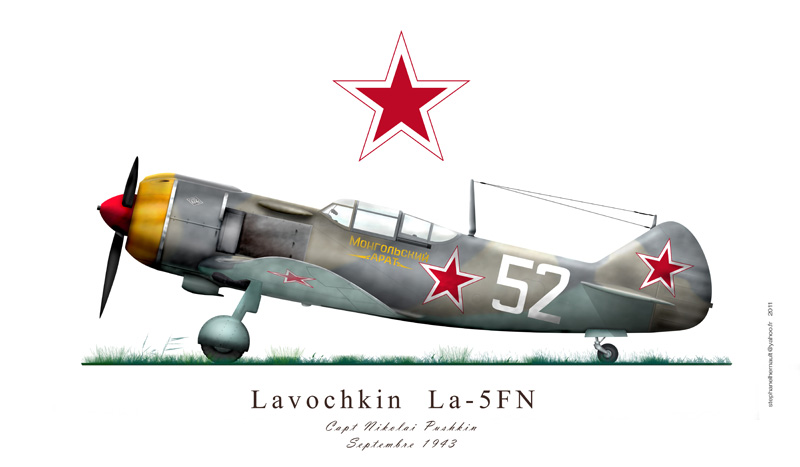
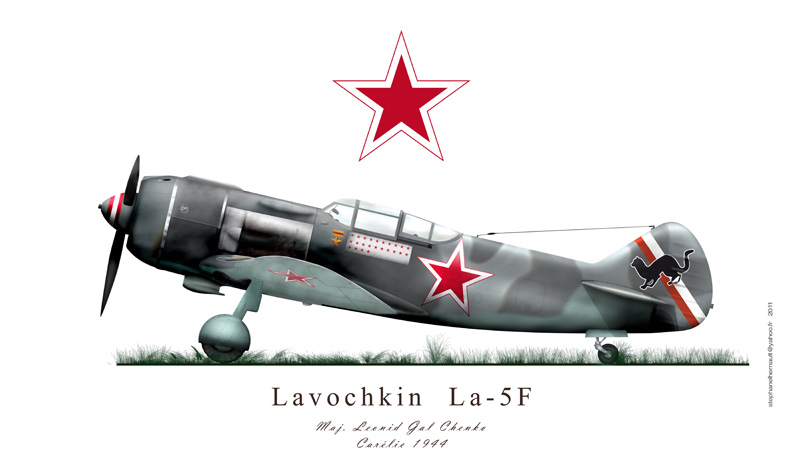
The La-5 was baptized by fire on August 14, 1942 as part of the 49th IAP in the Ulyanovo-Sukhinichi-Kozelsk region. From 14 to 24 August 1942, the regiment’s pilots on 19 aircraft (then under the brand name LaG-5) flew 180 sorties, having flown 130 hours. In 27 air battles, the regiment’s pilots shot down 16 enemy aircraft. During this time, 5 LaG-5s were shot down in the regiment, 2 did not return from a combat mission, 4 crashed, being hit in air battles, 1 crashed due to a motor defec.
On August 20, 1942, as part of the 240th IAP, it appeared at Stalingrad. The regiment began fighting on August 20, 1942, and until August 29, 1942, made 109 sorties, conducted 58 air battles, shot down 10 aircraft, but was defeated itself – only a few pilots remained in the ranks. The remnants of the regiment were relocated to the rear airfield, and then completely withdrawn to the reserve. Despite the fact that due to the lack of a sufficient number of experienced pilots, losses were large, the La-5 immediately performed well. For German pilots, the appearance of a new aircraft was a very unpleasant surprise. After the Battle of Stalingrad La-5 ceased to be a surprise for the Germans, aircraft of this type began to appear on all sectors of the Soviet-German front.
In the summer of 1943, a completely new La-5 made an emergency landing at a German airfield, which gave the Germans the opportunity to conduct comprehensive flight tests of the machine. Test pilot Hans-Werner Lerche wrote a detailed report.
La-5s took part in battles from the end of 1942 to the summer of 1943, after which they were replaced by more advanced versions of La-5F, La-5FN and subsequently La-7. Although some La-5s fought in 1944.
The most widely used La-5 was during the Battle of Kursk. It was here (at the Urazovo airfield), on La-5, that the famous Soviet ace Ivan Kozhedub opened his battle score. During the 4th sortie on July 6, 1943, Kozhedub shot down his first German aircraft, the Junkers Ju-87 bomber. By the end of the Battle of Kursk, Kozhedub had won nine aerial victories, and was awarded the Order of the Battle Red Banner. The famous Soviet pilot Aleksey Maresyev also flew on the La-5 plane, having lost his legs and despite this managed to return to combat aviation on prostheses.
In addition, on the Kursk Bulge, the La-5FN began to be massively used, which was opposed by the German FW 190A fighter. Strictly speaking, La-5 and FW-190A had already met in battles more than once, but a bet was made on them near Kursk – fighters with air-cooled engines were to gain air supremacy. The battles showed that, despite all its many advantages, the Fokker is inferior to the Lavochkin as an air combat fighter. Soviet pilots have always noted that it is more difficult to fight with the ‘Messers’ than with the FW-190. The Germans themselves realized this. On the Eastern Front, the Messerschmitt Bf 109 remained the main fighter until May 9, 1945.
